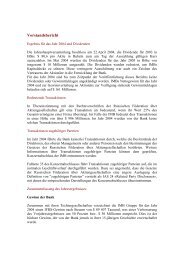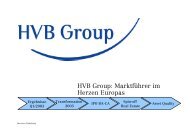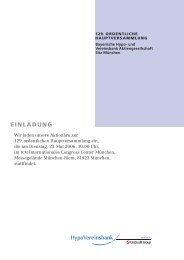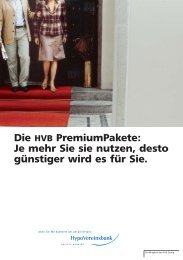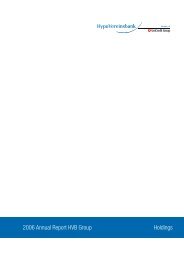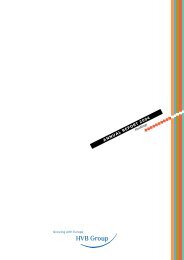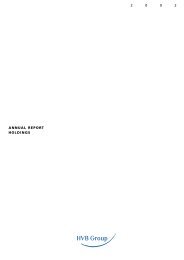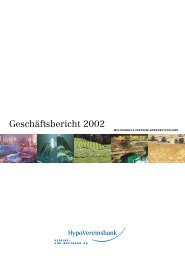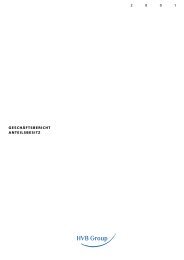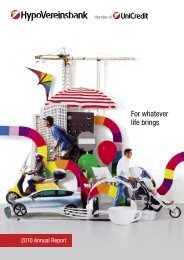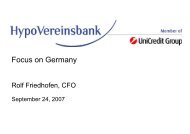Meeting real needs with concrete solutions. - Investor Relations ...
Meeting real needs with concrete solutions. - Investor Relations ...
Meeting real needs with concrete solutions. - Investor Relations ...
Create successful ePaper yourself
Turn your PDF publications into a flip-book with our unique Google optimized e-Paper software.
The regulatory environment represents a further factor of<br />
uncertainty for our industry. In short, we all benefit from a<br />
stable financial system: the banks, our customers, governments<br />
and the public at large. This is the point of tightening<br />
the capital and liquidity requirements under Basel III. For this<br />
reason, I welcome the new set of rules relating above all to<br />
core Tier 1 capital.<br />
Of course this is made all the easier for me by the excellent<br />
capital base at HVB. Our core Tier 1 ratio of 15.6% makes us<br />
one of the most stable banks not only in Germany but<br />
anywhere in Europe. Furthermore, we enjoyed an adequate<br />
liquidity structure and solid financing base at all times in the<br />
2011 financial year. And HVB’s leverage ratio (ratio of total<br />
assets to shareholders’ equity shown in the balance sheet)<br />
is also rock solid at 16.5x. Moreover, our parent company,<br />
UniCredit, completed a very successful €7.5 billion capital<br />
increase at the start of 2012, at an early date taking it well<br />
beyond the core capital ratios demanded by the EU bank<br />
supervisors.<br />
With regard to the new regulations, it must be the case that<br />
the rules are fair; individual countries and financial institutions<br />
must not be put at a disadvantage. Last year, I made no<br />
bones of the fact that, as far as I’m concerned, HVB has been<br />
hit harder than most by the bank levy. It cannot be right that<br />
a bank <strong>with</strong> our balance sheet and risk positions is required<br />
to make the second-biggest contribution to the German crisis<br />
fund. There is clearly a need for legislators to act in this area.<br />
Our results for 2011 are further evidence of the resilience of<br />
our business model. Due to the difficult capital market<br />
environment predominantly in the second half of the year,<br />
our pre-tax profit of €1.6 billion failed to quite match the<br />
very good figure of €1.9 billion reported in 2010. The results<br />
for 2011 again underscore our profitability and solidity as<br />
well as the strength of our customer business.<br />
We were once again able to reduce our loan-loss provisions<br />
after we had already more than halved such provisions<br />
year-on-year to €632 million in 2010. The beneficial lending<br />
environment allowed us to report loan-loss provisions at a<br />
very low level of just €266 million in 2011.<br />
Our strict cost management programme also has a long-term<br />
horizon. The increase of five percent or €178 million in<br />
operating costs in 2011 was caused among other things by<br />
the bank levies outside of Germany that we had to pay for<br />
the first time in Austria and the UK. Without these items and<br />
adjusted for consolidation and currency effects, the cost<br />
increase was moderate, at around two percent (please refer<br />
to the Financial Review for further information about the<br />
annual results).<br />
As in previous years, our Corporate & Investment Banking<br />
division (CIB), which was formed in 2009 when the former<br />
Corporates & Commercial Real Estate Financing and Markets<br />
& Investment Banking divisions were merged, made a major<br />
contribution to our commercial success. Sadly, though, we<br />
were unable to escape the difficult capital market environment<br />
I mentioned earlier; the sharp decline in market<br />
activities in the second half of the year left clear traces in our<br />
net trading income, which fell sharply accordingly. This also<br />
shaped the division’s pre-tax profit (€1,226 million compared<br />
<strong>with</strong> €1,384 million in 2010).<br />
The Family & SME division (F&SME) performed well, recording<br />
higher operating income in 2011. The division generated a<br />
pre-tax profit of €147 million, comfortably beating the<br />
year-ago figure of €114 million. As part of our One for Clients<br />
project, business customers <strong>with</strong> annual revenues of up to<br />
€50 million have been served by F&SME since the start of<br />
2011. Also allocated to this division are retail customers <strong>with</strong><br />
free assets of less than €500,000.<br />
HypoVereinsbank · 2011 Annual Report 11



